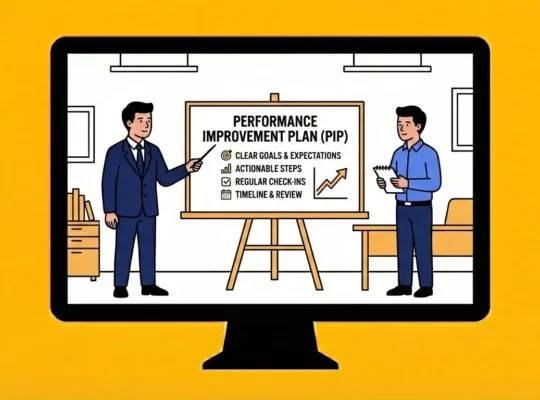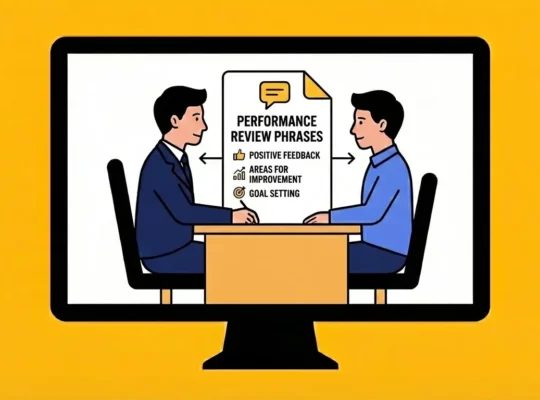High-performing teams are the innovation engines that fuel groundbreaking ideas and exceptional results. It is a challenging but highly rewarding process for organizations that dedicate time, energy, and resources to build high-performing teams. To help companies achieve their goals and attain the best version of themselves, Review.jobs offers dedicated tools to make employee voices heard and drive performance. Let’s crack the code and unlock the secrets to building a team that thrives, not just survives!
Table of Contents
- I. 8 Characteristics of High-Performing Teams
1. Clear Goals and Objectives
2. Effective Communication
3. Defined Roles and Responsibilities
4. Trust and Mutual Respect
5. Collaborative Environment
6. Constructive Feedback and Continuous Improvement
7. Strong Leadership
8. Accountability and Responsibility
II. Practical Strategies for Building High-Performing Teams
1. Ensuring Psychological Safety
2. Highlighting Prosocial Purpose
3. Encouraging Innovation
4. Promoting Diversity and Inclusion
5. Sponsoring Training and Development
I. 8 Characteristics of High-Performing Teams
1. Clear Goals and Objectives
High-performing teams thrive on clear goals and objectives. These teams consistently set and achieve targets that align seamlessly with the organizational priorities. This alignment ensures that every team member understands their role in contributing to the larger mission of the organization.
- Alignment with organizational priorities: High-performing teams understand how their work contributes to the bigger picture. They regularly review and adjust their objectives to stay in sync with the company’s strategic direction.
- Regular goal-setting and planning: These teams engage in frequent goal-setting sessions, ensuring that everyone is on the same page and working towards common objectives. This practice fosters a sense of purpose and direction, enabling the team to focus on what truly matters.
2. Effective Communication
Effective communication is a hallmark of any high-performing team. It involves open, honest, and respectful communication, creating an environment where team members feel valued and heard. According to research, effective communication is a critical component of increasing team motivation and performance, which will result in a 25% increase in team productivity. This statistic underscores the value of maintaining robust communication practices within high-performing teams, a complicated process made easy with the use of Review.jobs.
Review.jobs is a certified employee review platform, created to support companies by managing employee feedback smartly and effectively. It deploys tools and AI to collect, manage, analyze, and showcase employee experience.
How does Review.jobs ensure effective communication?
- Varied Voices, Deeper Insights: Go beyond basic surveys. We use a combination of employee satisfaction surveys, tailored review collection options, and API integrations to capture a comprehensive picture of your workforce experience.
- Confidentiality Guaranteed: Anonymised feedback requests and secure submissions ensure your employees feel comfortable speaking their minds honestly. Transparency matters, and so does employee trust.
- Authenticity First: Authentic employee reviews can be your biggest asset in building a strong employer brand. That is why we prioritize genuine feedback, not incentivized reviews. This means the insights you receive are pure and actionable.
- Effortless Feedback: Getting feedback shouldn’t be a chore. We make it easy, with direct email invitations and a platform for seamless anonymous feedback collection.
3. Defined Roles and Responsibilities
For a team to function efficiently, there must be a clear understanding of individual roles within the team. When each team member knows their responsibilities, it enhances accountability and ensures that tasks are completed effectively.
- A clear understanding of individual roles: High-performing teams have well-defined roles, allowing members to focus on their specific tasks without unnecessary overlap. This clarity helps each member to understand what is expected of them and how their work contributes to the team’s overall objectives.
- Prevention of conflicts and confusion over project ownership: When roles are clearly delineated, it reduces the potential for conflicts and misunderstandings about who owns which part of a project. This prevents unnecessary friction and allows the team to work more harmoniously.
4. Trust and Mutual Respect
A foundation of trust and mutual respect is essential for any high-performing team. Trust enables team members to rely on one another, fostering a collaborative and supportive environment.
- Building a foundation of trust and respect among team members: Trust is built through consistent, reliable interactions and genuine respect for each other’s contributions. When team members trust each other, they are more likely to share ideas and take risks, knowing they have the support of their peers.
- Encouragement of diverse perspectives and mutual support: High-performing teams value diverse perspectives, understanding that different viewpoints can lead to better problem-solving and innovation. By encouraging mutual support, team members create an environment where everyone feels valued and empowered to contribute their best work.
5. Collaborative Environment
A collaborative environment is crucial for fostering teamwork and achieving high performance. High-performing teams understand the value of working together and leveraging each other’s strengths to reach common goals. According to a TeamStage survey, 75% of employees believe that teamwork and collaboration are essential components for corporate success.
- Fostering collaboration and teamwork: High-performing teams actively create opportunities for collaboration. They use strategies such as brainstorming sessions, joint problem-solving activities, and regular team meetings to encourage collective input and shared responsibility.
- Breaking down silos and encouraging cross-functional teamwork: Successful teams break down barriers between departments and encourage cross-functional collaboration. By promoting interaction across different areas of expertise, they enhance innovation and ensure that diverse perspectives contribute to the team’s performance.
6. Constructive Feedback and Continuous Improvement
A culture of continuous feedback and improvement is integral to the success of high-performing teams. By consistently seeking and providing constructive feedback, teams can adapt and grow, turning challenges into opportunities for development.
- Culture of continuous feedback and improvement: High-performing teams embrace a feedback-rich environment where every member can receive and give feedback constructively. This practice helps identify areas for improvement and fosters a mindset geared towards excellence.
- Encouragement of learning from mistakes and ongoing development: These teams view mistakes as valuable learning experiences. By encouraging continuous learning and development, they create an environment where team members feel empowered to innovate and take calculated risks, knowing that their growth is supported.
7. Strong Leadership
Effective leadership is the cornerstone of high-performing teams. Leaders who set clear expectations and motivate their teams create an environment where members are aligned with the organization’s vision and goals.
- Effective leadership that sets clear expectations: Strong leaders provide a clear roadmap for what needs to be achieved and inspire their team to strive for excellence. They communicate the team goals effectively and ensure everyone understands their role in achieving these objectives.
- Examples of leaders who have driven high-performing teams to success: Consider leaders like Satya Nadella at Microsoft, who transformed the company’s culture by emphasizing empathy, innovation, and collaboration. His leadership style fostered a more inclusive and high-performing environment, leading to significant growth and success.
8. Accountability and Responsibility
Holding team members accountable for their contributions is essential for maintaining high performance. An environment where accountability is a priority ensures that everyone is responsible for their part in the team’s success.
- Holding team members accountable: High-performing teams implement systems to track and review individual and team performance regularly. This practice helps identify areas for improvement and ensures that everyone is contributing to their fullest potential.
- Establishing a results-oriented culture: By focusing on outcomes rather than just activities, high-performing teams drive towards achieving their goals efficiently. This results-oriented approach creates a sense of ownership and responsibility among team members, encouraging them to deliver their best work consistently.
III. Practical Strategies for Building High-Performing Teams
1. Ensuring Psychological Safety
Creating an environment where team members feel safe to express themselves is essential for building high-performing teams. When team members know they can share their thoughts, ideas, and concerns without fear of judgment or retaliation, they are more likely to engage fully and contribute to the team’s success.
- Creating an environment where team members feel safe expressing themselves: Psychological safety exercises allow them to speak up, ask questions, and offer innovative ideas. Leaders can foster this environment by showing appreciation for diverse viewpoints and constructively addressing conflicts.
- Encouragement of interpersonal risk-taking and constructive conflict: High-performing teams understand that conflict can be a source of growth and innovation. Encouraging constructive conflict and healthy debate leads to better decision-making and stronger team dynamics.
2. Highlighting Prosocial Purpose
A Gallup study found that businesses with the highest levels of employee engagement had 21% higher levels of profitability. And who says engagement, says retention! According to recent research, high-performing employees are 87% less likely to leave their organization.
Among the most effective employee engagement programs, ensuring team members understand the value and impact of their work is a step to not ignore. When individuals see how their efforts contribute to the greater organizational mission, they are more likely to be committed and perform at their best.
- Ensuring team members understand the value and impact of their work: Communicating how each person’s role fits into the larger picture helps to foster a sense of purpose and belonging. This understanding can drive higher levels of engagement and job satisfaction.
- Connecting individual tasks to the greater organizational mission: By linking day-to-day tasks to the company’s overarching goals, leaders can help team members see the significance of their contributions. This connection not only enhances motivation but also aligns individual efforts with the organization’s strategic objectives.
3. Encouraging Innovation
High-performing teams excel in environments where innovation is a priority. These teams are not afraid to embrace change and constantly seek out new ways to improve processes, products, and services. According to a survey conducted by Thinkwiseinc, high-performing teams are more likely to successfully implement innovations. This capability to innovate keeps them ahead of the curve and continuously improves their performance.
- Embracing change and encouraging innovation: High-performing teams view change as an opportunity rather than a threat. They encourage team members to bring forward new ideas and experiment with different approaches. This openness to innovation fosters a culture where creativity is valued and nurtured.
- Adapting swiftly to new challenges and opportunities: The ability to quickly adapt to new circumstances is a defining trait of high-performing teams. Whether facing market shifts, technological advancements, or unexpected challenges, these teams remain agile and responsive. This adaptability ensures they can capitalize on opportunities and mitigate risks effectively.
4. Promoting Diversity and Inclusion
Promoting diversity and inclusion is essential for fostering a creative and innovative team environment. High-performing teams understand that diverse perspectives lead to more robust problem-solving and innovative solutions. In fact, studies found that inclusive teams make 87% better decisions and make decisions twice as fast in half of the meetings.
- Promoting diversity of thought and inclusive practices: High-performing teams actively seek out and value diverse viewpoints. They create an inclusive environment where all team members feel respected and heard, which encourages the free exchange of ideas and perspectives.
- Leveraging diverse backgrounds to drive creativity and innovation: Teams that draw on a wide range of experiences and backgrounds are better equipped to approach problems creatively. This diversity enhances their ability to innovate and find unique solutions to complex challenges.
5. Sponsoring Training and Development
Investing in team members’ growth and development is a cornerstone of building high-performing teams. Organizations that prioritize continuous learning create an environment where employees feel valued and motivated to improve their skills and knowledge, key components of remarkable employee branding.
- Investing in team members’ growth and development: High-performing teams thrive when their members are given opportunities to expand their skill sets. This investment can take many forms, including funding for external courses, access to online learning platforms, or internal workshops tailored to specific team needs. By fostering a culture of growth, organizations can enhance both individual and team performance.
- Providing opportunities for training, coaching, and mentoring: Structured training programs, coaching sessions, and mentoring relationships are crucial for employee development. Training programs can address skill gaps and prepare team members for future roles within the organization. Coaching provides personalized guidance, helping individuals navigate challenges and leverage their strengths. Mentoring, on the other hand, connects less experienced team members with seasoned professionals, facilitating knowledge transfer and career development.
As workplaces evolve, the need for adaptability and continuous improvement in team dynamics remains critical. By focusing on these strategies, businesses can enhance their employer image and attract top talent. At Review.jobs, we believe that fostering high-performing teams is essential for long-term success. Embrace these practices to build teams that drive innovation and excellence.





